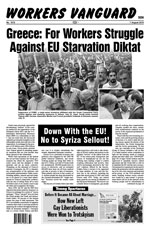
New Spartacist Pamphlet Newly available for purchase is our publication Then and Now, which explains how class-struggle leadership made a key difference in three citywide strikes in 1934. We reprint below the pamphlet’s introduction describing its contents. The “Then and Now” article in this pamphlet addresses the crucial political lessons of the 1934 strikes by Minneapolis truckers, maritime workers on the West Coast and Toledo auto parts workers. Waged amidst the all-sided destitution of the Great Depression, these strikes, like others that year, confronted the strikebreaking forces of the capitalist state. A key difference was that these strikes won. What made this outcome possible is that their leaders were, at the time, committed to a program of class struggle. Unlike other trade-union leaders of that day—and today—they did not buy into the notion that the workers had interests in common with the employers, their political parties or their state. Instead, these strikes were fought by mobilizing the mass strength and solidarity of the workers in opposition to the forces of the capitalist class enemy. The review of Bryan Palmer’s book Revolutionary Teamsters provides a more in-depth study of the Minneapolis truckers’ strikes, which were led by the Trotskyists of the Communist League of America (CLA). Here they confronted the Farmer-Labor Party (FLP) governor of Minnesota, Floyd Olson, who commanded the allegiance of many workers with his often radical-sounding, friend-of-the-little-guy rhetoric. The FLP postured as a “third party” alternative to both the Democrats and Republicans, but it was no less a capitalist party. This is effectively addressed in the 1930 article “The Minnesota F.L.P.” by Vincent Dunne, who went on to become a central leader of the truckers’ strikes. As Dunne makes clear, the two-class Farmer-Labor Party was based on the subordination of the workers’ struggles to farmers and other petty-bourgeois forces “whose political outlook is bounded by the illusion that it is possible to achieve security under the capitalist order.” After an on-again, off-again alliance with the Democratic Party, the FLP finally merged with the Democrats in 1944. Dunne and other CLA leaders of the Minneapolis strikes had been armed for battle against farmer-labor populism by Russian revolutionary leader Leon Trotsky, who in the early 1920s had intervened to pull the young American communist movement back from giving political support to the capitalist “third party” candidacy of Robert La Follette, a maverick Republican Senator from Wisconsin. The excerpts from Trotsky’s introduction to his book, The First Five Years of the Communist International, summarize his opposition to this opportunist course which, if pursued, would have politically liquidated the fledgling Communist party. Today, what remains of the gains that were won through the momentous class battles of the past continues to be ravaged in a one-sided class war enabled by trade-union misleaders, who have long forsaken the very means through which the unions were founded. The working class, the poor, black people, immigrants and countless others at the bottom of this society have paid the price in busted unions, broken lives and all-sided misery. To be sure, it is not easy for the workers to win in the face of the forces arrayed against them. Many strikes, even very militant ones, will lose. But as was demonstrated in the three 1934 strikes addressed in this pamphlet, when important working-class battles are won it can dramatically alter the situation. These victories inspired a huge labor upsurge later in the 1930s that built the mass industrial unions in this country. Hard-fought strikes can provide an important school of battle for the workers in which they learn the power of their collective strength and organization and begin to understand the class nature not only of the capitalist system but of the government, laws and political parties that defend its rule. But while able to strike important blows against the conditions of the workers’ exploitation, trade-union struggle on its own cannot end that exploitation. To win that war there must be a struggle for working-class power under the leadership of a revolutionary party that can arm the workers with the understanding and consciousness of their class interests in the fight to emancipate labor and all of the oppressed from the bondage of capitalist exploitation.
|
|
||||||||||||||||||||||||||||||||||||||||||||||||
